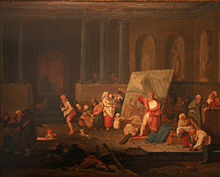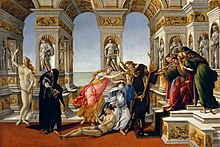Apelles
Apelles ( Greek Ἀπελλῆς ) was one of the most important painters of ancient Greece and of all antiquity; he was a contemporary of Alexander the great , born about 375-370 BC. Chr. In colophon (?); died towards the end of the 4th century BC In Kos (?).
None of his paintings have survived to us, they have only been handed down in literary form.
Life
Apelles was trained as an artist in Ephesus . His teachers were Ephorus of Ephesus and Pamphilus of Sicyon . In Philip's time he went to Macedonia. It was here that Alexander met him, who allegedly alone allowed him to paint him, a privilege that the ore caster Lysippus and the stone cutter Pyrgoteles also had for their art. From Macedonia Apelles seems to have made several journeys and to have stayed for a long time in Rhodes, Kos and Ephesos. After Alexander's death he turned to the court of Ptolemy in Alexandria, but later returned to Ephesus.
Apelles was considered the "coronation of ancient painting". The also famous painter Protogenes was a rival of Apelles.
Work and meaning
Grace , sensual charm, blooming color, paired with the scientific rigor and correctness of the Sicyon school, were, according to the testimonies of the ancients, the advantages of his works, which were particularly evident in the famous Aphrodite Anadyomene in the Asclepius temple in Kos . For Aphrodite emerging from the sea, Apelles also used the famous hetaera Phryne as a model.
Of his other works, the most celebrated were: Alexander with lightning in hand (for the Temple of Artemis at Ephesus ), a Charis (in the Odeon at Smyrna ), an Artemis among sacrificing virgins, a Heracles , Alexander mounting the chariot , and other portraits, e.g. B. a picture of Leonidas of Taranto (in the temple of Divus Iulius in Rome).
The satirist Lucilius mentions Apelles in a fragment:
- "Because I have seen a painting by Apelles that is far above all other works of art that I have seen in my life"
The satirist Petronius also mentions a work by Apelles in the Satyricon , entitled " monocremon ". The protagonist Encolp is (in Naples?) In a picture gallery and admires the old masters.
- “But the so-called man on one leg of Apelles completely made me sink into adoration. For the contours in the pictures were drawn from life with such delicacy that one might have thought that painting had also captured the mental processes. On one side the eagle abducted the shepherd from Ida high in the air ; on the other, Hylas , radiantly beautiful, pushed back the intrusive naiad . Apollo cursed his killer hands and delighted his still relaxed lyre with the flower that had just emerged . "
Also famous was the painting "The Defamation", of which Lukian reports:
- “On the right side of the picture sits a man with long ears that are missing little that could be mistaken for Midas ears. His hand is outstretched at the slander that comes from the background. Next to him are two female figures whom I see as ignorance and distrust. From the left side he is approached by the slander in the form of an extraordinarily charming but heated and excited girl, whose features and movements express anger and anger: in her left hand she holds a burning torch; with her right hand she is dragging a young man by the hair, who is holding up his hands to heaven and calling the gods to witness. A pale, ugly man walks in front of her with a piercing look who looks as if a long illness had emaciated him: everyone will see envy in him. Behind it come two female figures who talk about the slander and seem to dress it up and decorate it: These are - as the museum guide explained to me - the fraud and the deception. At the very back follows a mourning figure in a black, torn robe: the repentance, who turns backwards weeping and looks at the approaching truth full of shame. "

According to the description, this famous painting was repeated several times during the Renaissance, around 1495 by Botticelli (see Die Verleumdung des Apelles ) and by Albrecht Dürer when painting the Great Council Chamber in Nuremberg City Hall around 1521 (only fragments preserved). Likewise, the (legendary) theme "Apelles paints Kampaspe" (poem by John Lyly ) was taken up several times during the Renaissance. Alexander the Great is said to have given his lover Kampaspe to Apelles after the painter fell in love with his model.
Strongly deepened shadows and thus strongly raised light areas characterized all of his paintings; but he only used four main colors (white, red, yellow, black, of course with their nuances and mixtures).
In addition, he gave his paintings a peculiar varnish not only protection against moisture and dust, but also more delicacy and delicacy of expression. The same grace that spread over the paintings of Apelles seems to have been the keynote of his whole life. Aware of his mastery, Apelles was above jealousy of his fellow artists. We have received anecdotes from him that illuminate his impartiality, modesty and character size. Apelles also tried his hand at being a writer, the author of a textbook addressed to his pupil Perseus.

The saying “ cobbler, stick to your last ” goes back to an anecdote about Apelles. After that he would have liked to hide behind his pictures to listen to the judgment of the viewer. Once a shoemaker would have complained that the painted shoes did not have one eyelet. Apelles corrected the picture. But now the shoemaker also had something to complain about with his thighs. Thereupon Apelles replied: The shoemaker cannot judge what is above the shoe. The anecdote was passed down in Latin by Pliny the Elder : "... ne supra crepidam sutor iudicaret ...", hence the Latin phrase "Ne supra crepidam sutor", also quoted as "Ne sutor supra crepidam", "Ne sutor ultra crepidam "(probably the most common variant) or" Sutor, ne ultra crepidam! ".
Apelles is the first artist who is said to have made a self-portrait .
literature
- Werner Krenkel: Apelles at Petron and Lucilius. In: Scientific journal of the University of Rostock. 17.7 / 8 (1968) 689-695.
- Rainer Vollkommer (Hrsg.): Artists lexicon of antiquity . Volume 1: A-K. Saur, Munich / Leipzig 2001, ISBN 3-598-11413-3 , pp. 62-64 sv Apelles (I) (G. Bröker).
- Bernard Andreae : Apelles of Colophon. The Telephos picture from Herculanum in the ancient and modern art judgment . Treatises of the humanities and social sciences class / academy of sciences and literature. Mainz, 2011, 2.
- David Cast: Simon the Shoemaker and the Cobbler of Apelles . In: Source . 28 (2008) 1-4.
- Christiane J. Hessler: Ne supra crepidam sutor! Shoemaker, stick to your last. The dictum of Apelles from Petrarch to the end of the Quattrocento . In: Fifteenth Century Studies . 33 (2008) 133-150.
Web links
- Sara Agnoletto: La Calunnia di Apollo: recupero e riconversione ecfrastica del trattatello di Luciano in Occidente La rivista di engramma 42, July – August 2005
- Sara Agnoletto: Una galleria delle Calunnie di Apelle: fonti iconografiche e testuali (1408-1875) .
Remarks
- ↑ Pliny Natural History 35, 80–83, Quintilian 12, 10, 6.
- ↑ Athenaios The Scholar's Supper 591a.
- ↑ Lucilius, Frg. 816-7.
- ↑ Petron. 83, 2f., German translation by Konrad Ehlers (1965). Müller / Ehlers correct the traditional incomprehensible monocremon to monocnemon . Krenkel (1968) 691 argues that the entire Petron passage quoted refers to the picture of Apelles. Krenkel draws close connections to the above-mentioned fragment of Lucilius and considers an identity of the paintings to be possible.
- ↑ Lukian Calumnia 2, quoted in n. Krenkel (1968) 689f. The defamation is "the only so extensively described" painting by Apelles (Krenkel).
- ↑ Naturalis historia , Book XXXV, Section 85 (in Chapter xxxvi)
| personal data | |
|---|---|
| SURNAME | Apelles |
| BRIEF DESCRIPTION | Greek painter |
| DATE OF BIRTH | around 375-370 BC Chr. |
| PLACE OF BIRTH | uncertain: colophon |
| DATE OF DEATH | 4th century BC Chr. |
| Place of death | unsure: Kos |

